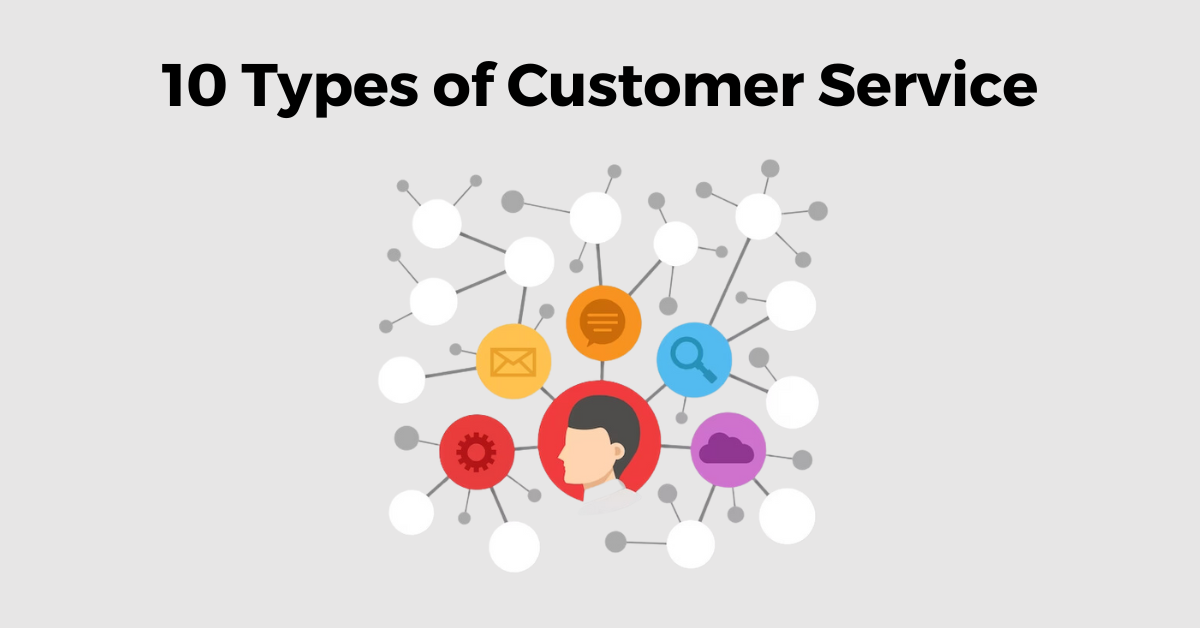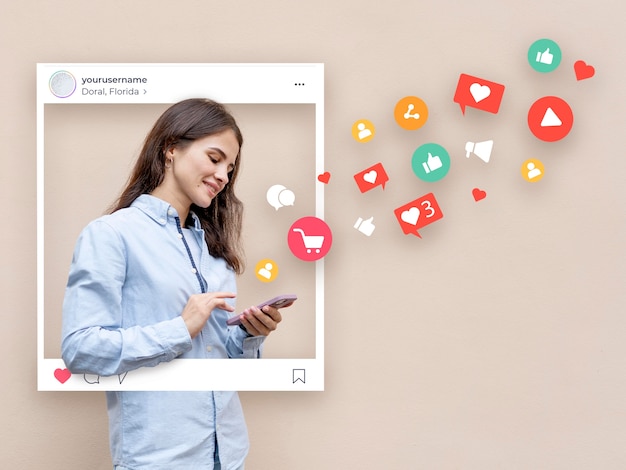10 Types of Customer Service That Will Delight Your Customers

Customer service is the process of providing support and assistance to customers. It is an essential part of any business, as it can help to improve customer satisfaction, loyalty, and advocacy.
There are many different types of good customer service, each with its own advantages and disadvantages. The best type of customer service system for your business will depend on your target market, industry, and budget.
In this blog post, we will discuss the 10 most common types of customer service and how you can use them to delight your customers.
10 Different Types of Customer Service
Here are the 10 different types of customer services:
Self-service

Self-service customer service allows customers to help themselves without having to contact a customer service representative. This can be done through a variety of channels, such as knowledge bases, FAQs, chatbots, and tutorials.
Benefits of self-service customer service
There are many benefits to self-service customer service, including:
- Convenience: Customers can get help whenever they need it, without having to wait on hold or speak to a representative.
- Flexibility: Customers can choose the method of self-service that works best for them, such as reading a knowledge base article or chatting with a chatbot.
- Reduced costs: Self-service can help to reduce customer service costs by deflecting calls and emails from customer service representatives.
- Improved customer satisfaction: Customers often appreciate the convenience and flexibility of self-service.
Examples of self-service customer service
Here are some examples of self-service customer service:
- Knowledge base: A knowledge base is a collection of articles and other resources that customers can use to find answers to their questions. Knowledge bases can be hosted on a company's website or in a dedicated app.
- FAQs: FAQs, or frequently asked questions, are a list of common questions and answers. FAQs can be found on many company websites and in customer support portals.
- Chatbots: Chatbots are computer programs that can simulate conversation with humans. Chatbots can be used to answer customer questions, provide support, and even complete tasks.
- Tutorials: Tutorials are step-by-step guides that can teach customers how to use a product or service. Tutorials can be found on company websites, in types of customer support portals, and on YouTube.
Live chat customer service

Live chat customer service allows customers to chat with a customer service representative in real time. This is a good option for customers who need immediate help or who have complex questions.
Benefits:
- Convenience: Live chat is a convenient way for customers to get help without having to pick up the phone or send an email. Customers can chat with a type of customer service representative while they are browsing your website or using your app, which can save them time and hassle.
- Speed: Live chat is a fast way for customers to get help. Representatives can typically respond to live chat messages within minutes, which can help to resolve customer issues quickly.
- Personalization: Live chat allows for more personalized customer service than other channels, such as email or IVR. Representatives can see what the customer is doing on your website or in your app, and they can use this information to provide more relevant and helpful assistance.
Examples:
- A customer is trying to purchase a product on your website, but they are having trouble checking out. They can use live chat to get help from a customer service representative.
- A customer is using your app, but they are confused about how to use a certain feature. They can use live chat to get help from a customer service representative.
- A customer is having a problem with their account. They can use live chat to get help from a customer service representative.
Phone support

Phone support is a type of customer service that allows customers to speak to a customer service representative on the phone. This is a good option for customers who need immediate help, who have complex questions, or who prefer to speak to a person.
Benefits of phone support:
- Immediate assistance: Phone support is a great way to get immediate assistance from a customer service representative. This is especially helpful if you have a problem that needs to be resolved quickly.
- Complex questions: Phone support is also a good option for customers who have complex questions. Customer service representatives can provide more in-depth assistance over the phone than they can through other channels, such as email or chat.
- Human interaction: Some customers prefer to speak to a person when they have a problem. Phone support gives customers the opportunity to interact with a human being and to get their problem resolved quickly and efficiently.
Examples of phone support:
- A customer calls a customer service representative to get help with a problem they are having with their internet service.
- A customer calls a customer service representative to ask about a product they are interested in purchasing.
- A customer calls a customer service representative to return or exchange a product.
E-mail support

Email support is a type of customer service that allows customers to communicate with a customer service representative through email. This is a good option for customers who have less urgent questions or who prefer to communicate in writing.
Benefits of email support:
- Convenience: Email support is convenient for customers because they can send an email at any time and from anywhere. They can also take their time writing their email and ensure that they have clearly communicated their issue.
- Asynchronous communication: Email support is asynchronous, which means that customers do not have to wait on hold for a customer service representative. They can send an email and then go about their day, knowing that they will receive a response when the representative is able to review it.
- Written record: Email support provides a written record of the communication between the customer and the customer service representative. This can be helpful if the customer needs to reference the conversation later on.
Examples of email support:
- A customer emails a customer service representative to ask about the status of their order.
- A customer emails a customer service representative to request a refund for a product that they are not satisfied with.
- A customer emails a customer service representative to ask for help troubleshooting a technical issue.
Social media support

Social media support is on of the popular types of customer service that allows customers to contact customer service representatives through social media platforms like Twitter, Facebook, and Instagram. This is a good option for customers who are already active on social media or who prefer to communicate through this channel.
Benefits of social media support:
- Convenience: Social media is a convenient way for customers to contact customer service, as they can do so from anywhere in the world using their internet-connected device.
- Speed: Social media support can be a fast way to get help, as customer service representatives are often monitoring social media accounts for customer inquiries.
- Transparency: Social media support is transparent, as all interactions between customers and customer service representatives are visible to the public. This can help to build trust and credibility with customers.
Examples of social media support:
- A customer tweets a company to ask a question about a product. The company's customer service representative responds to the tweet within minutes and answers the customer's question.
- A customer posts a comment on a company's Facebook page to complain about a product. The company's customer service representative responds to the comment promptly and apologizes for the customer's experience. The customer service representative then works with the customer to resolve the issue.
- A customer sends a direct message to a company on Instagram to ask for help with a technical issue. The company's customer service representative responds to the direct message quickly and provides the customer with the necessary assistance.
- A customer inquires about an order status via a company's WhatsApp Business account. The company, using multiple WhatsApp Business accounts for various services, quickly identifies the right department. A representative responds promptly with the order details and expected delivery date.
Walk-in support

Walk-in support is one of the traditional types of customer service that allows customers to visit a physical location to receive assistance. This is a good option for customers who prefer to speak to a person in person or who need to return or exchange a product.
Benefits of walk-in support:
- Personal interaction: Walk-in support allows customers to interact with a customer service representative face-to-face. This can be helpful for customers who have complex questions or who need help with a technical issue.
- Immediate assistance: Walk-in support allows customers to receive assistance immediately. This is a good option for customers who have an urgent problem.
- Ability to see and touch products: For customers who are shopping for a product, walk-in support allows them to see and touch the product before they purchase it. This can help customers to make an informed purchase decision.
Examples of businesses that offer walk-in support:
- Retail stores: Retail stores typically offer walk-in support to their customers. This allows customers to ask questions about products, return or exchange products, and get help with technical issues.
- Banks: Banks typically offer walk-in support to their customers. This allows customers to open and close accounts, deposit and withdraw money, and get help with other banking services.
- Telecom companies: Telecom companies typically offer walk-in support to their customers. This allows customers to set up new phone and internet service, resolve billing issues, and get help with other telecom-related issues.
Video support

Video support is one of the digital types of customer service that allows customers to video chat with a customer service representative. This can be done through a variety of platforms, such as Skype, Zoom, and Google Meet.
Benefits of video support:
- It allows customers to see the customer service representative and vice versa. This can help to build trust and understanding between the customer and the representative.
- It can be used to provide visual assistance. For example, a customer service representative can use video support to help a customer troubleshoot a problem with their computer or to show them how to use a new product.
- It can be used to provide personalized support. A customer service representative can use video support to get to know the customer's individual needs and to tailor the customer service experience to those needs.
Examples of video support:
- A customer service representative for a software company can use video support to help a customer troubleshoot a problem with their software.
- A customer service representative for a hardware company can use video support to help a customer install a new piece of hardware.
- A customer service representative for a retail company can use video support to help a customer choose the right product or to show them how to use a product.
On-site support

On-site support is a type of customer service where a customer service representative visits a customer's location to provide assistance. This is a good option for customers who need help with a complex issue or who need assistance with a product that is difficult to transport.
Benefits of on-site support:
- Personalized service: On-site support allows customer service representatives to provide personalized service to each customer. They can take the time to understand the customer's specific needs and provide them with the best possible solution.
- Convenience: On-site support is convenient for customers because they do not have to travel to a physical location to receive assistance. The customer service representative will come to them, which can save them time and money.
- Expertise: On-site support representatives are typically highly trained and experienced. They have the knowledge and skills to resolve even the most complex issues.
Examples of on-site support:
- A computer technician visiting a customer's office to fix a computer problem
- A plumber visiting a customer's home to fix a leaky faucet
- An HVAC technician visiting a customer's business to repair an air conditioning unit
- A medical equipment technician visiting a hospital to repair an MRI machine
Interactive voice response (IVR)

Interactive voice response (IVR) is a type of customer service that allows customers to interact with a computerized system to get help. This can be done by pressing buttons on a phone keypad or by speaking to the system.
IVR systems are often used to route customers to the appropriate department, provide information about products or services, or take orders. IVR systems can also be used to resolve simple customer issues, such as resetting a password or checking the status of an order.
Benefits of IVR customer service:
- Efficiency: IVR systems can handle a large volume of calls simultaneously, which can help to reduce wait times for customers.
- Cost-effectiveness: IVR systems can help to reduce customer service costs by automating tasks that would otherwise be performed by human agents.
- 24/7 support: IVR systems can provide 24/7 support to customers, which can be helpful for businesses that operate outside of regular business hours.
Examples of IVR customer service:
- When you call a bank to check your account balance, you may be prompted by an IVR system to enter your account number and PIN.
- When you call a customer service department to report a problem with a product, you may be prompted by an IVR system to select the type of product you have and the nature of the problem.
- When you call an airline to book a flight, you may be prompted by an IVR system to enter your travel dates and destination.
Proactive customer service

Proactive customer service is a customer service approach that involves reaching out to customers before they have a problem to offer assistance. This can be done through surveys, emails, phone calls, or even social media.
The goal of proactive customer service is to anticipate customer needs and resolve potential issues before they become problems. This can help to improve customer satisfaction, loyalty, and advocacy.
Benefits of proactive customer service
- Improved customer satisfaction: Customers are more likely to be satisfied with their experience when they feel that their needs are being anticipated and met.
- Increased customer loyalty: Loyal customers are more likely to do repeat business with you and to recommend you to others.
- Reduced customer churn: Customer churn is the rate at which customers stop doing business with you. Proactive customer service can help to reduce customer churn by keeping customers happy and satisfied.
- Boosted sales: By improving customer satisfaction, loyalty, and reducing churn, proactive customer service can lead to boosted sales.
Examples of proactive customer service
- Sending a welcome email to new customers: This email can introduce your company and its products or services, and provide customers with information on how to contact customer service if they have any questions or problems.
- Reaching out to customers who have abandoned their shopping carts: This can be done via email or phone call. The goal is to find out why the customer abandoned their cart and to see if you can help them complete their purchase.
- Sending a reminder email to customers who have a scheduled appointment: This email can help to reduce the number of no-shows.
Personalized customer service

Personalized customer service involves getting to know each customer individually and tailoring the types of customer service experience to their specific needs. This can be done by collecting information about customers, such as their purchase history, preferences, and feedback. Once you have this information, you can use it to provide customers with more relevant and helpful customer service.
Here are some benefits of personalized customer service:
- Increased customer satisfaction: Customers are more likely to be satisfied with their experience when they feel like they are being treated as individuals.
- Improved customer loyalty: Customers are more likely to be loyal to a business that provides them with personalized customer service.
- Increased customer advocacy: Customers who are satisfied with their experience are more likely to recommend your business to others.
- Increased sales: Personalized customer service can lead to increased sales, as customers are more likely to purchase from a business that they feel understands and meets their needs.
Here are some examples of personalized customer service:
- Greeting customers by name: This shows customers that you are paying attention to them and that you value them as individuals.
- Recommending products based on customer preferences: This shows customers that you understand their needs and that you are interested in helping them find the right products for them.
- Providing personalized discounts and promotions: This shows customers that you appreciate their business and that you are committed to providing them with the best possible value.
How to Improve Customer Service with Manifest AI?

Manifest AI is a customer service chatbot that can help you improve your customer service in a number of ways:
- Provide 24/7 support: Manifest AI can provide customer support 24 hours a day, 7 days a week. This means that your customers can always get the help they need, even when your human customer service team is not available.
- Answer customer questions quickly and accurately: Manifest AI is trained on a massive dataset of text and code, which means that it can answer customer questions quickly and accurately, even the most complex ones.
- Personalize the customer experience: Manifest AI can learn about each customer's individual needs and preferences, and then tailor the customer service experience accordingly. This helps to create a more personal and engaging customer experience.
- Automate tasks: Manifest AI can automate many of the repetitive tasks that customer service representatives typically perform, such as answering simple questions, routing customers to the right department. This frees up your human customer service team to focus on more complex issues and provide a more personalized experience to customers.
Conclusion
In this blog post, we have discussed the 10 most common types of customer services and how you can use them to delight your customers.
The best types of customer service models for your business will depend on your target market, industry, and budget. However, all of the types of customer service discussed in this blog post can be effective in delighting customers if they are provided in a timely, efficient, and friendly manner.

.png)
